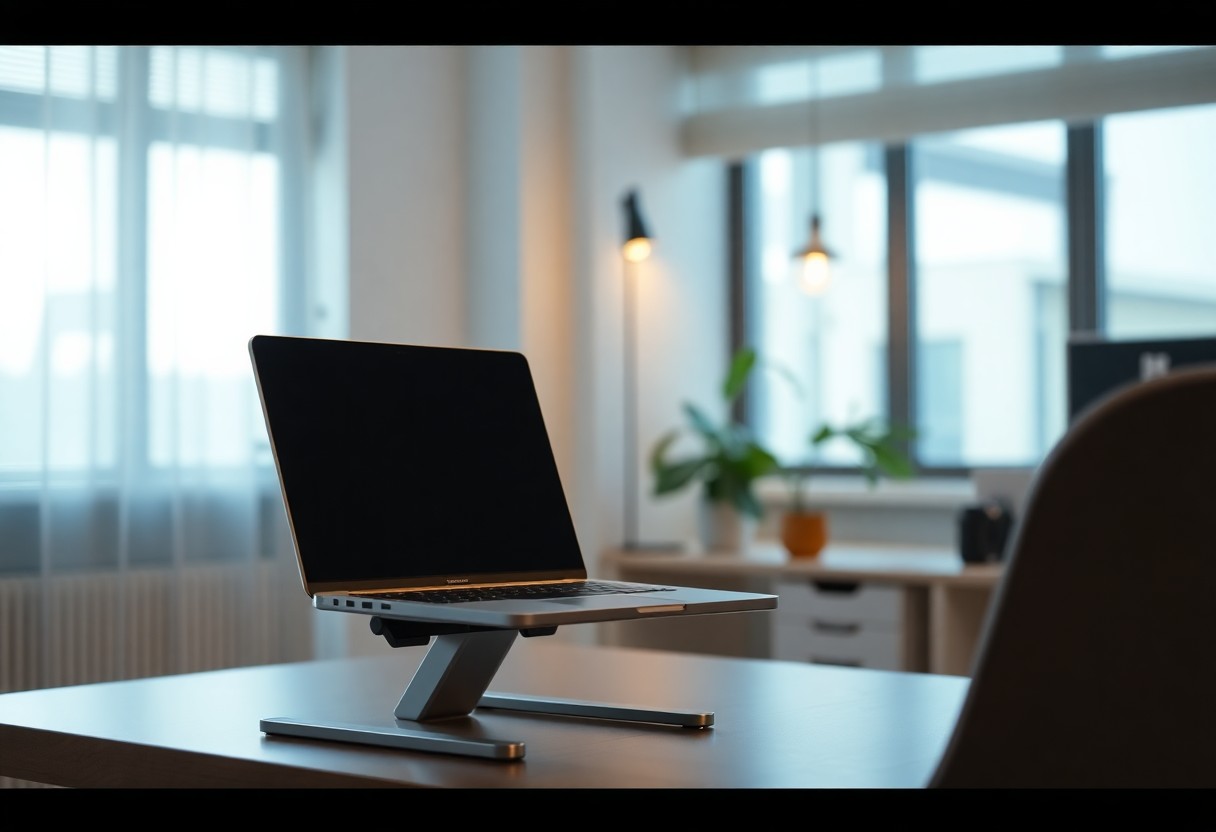Over time, you may find that prolonged laptop use can lead to discomfort or even pain, impacting your productivity and overall well-being. Understanding the principles of laptop ergonomics can provide significant relief from these issues, helping you maintain a more comfortable and healthier posture during extended sessions. This blog post will explore practical ergonomic adjustments you can make to your laptop setup, empowering you to enhance your workspace and minimize the strain on your body without sacrificing functionality.
Contents
- Understanding Ergonomics
- Definition of Ergonomics
- Importance of Ergonomics in Technology
- Common Ergonomic Issues with Laptops
- Poor Posture
- Eye Strain
- Key Ergonomic Features to Consider in Laptops
- Keyboard Design
- Screen Height and Brightness
- Accessories to Enhance Laptop Ergonomics
- Laptop Stands
- External Keyboards and Mice
- Best Practices for Extended Laptop Use
- Regular Breaks and Stretching
- Workspace Setup Recommendations
- Case Studies and Research Findings
- Impact of Ergonomic Improvements on Health
- User Experiences and Feedback
- Final Words
Understanding Ergonomics
The study of ergonomics focuses on optimizing your environment by creating a more comfortable and efficient workspace. It combines knowledge from various fields such as anatomy, psychology, and design to ensure that tools and tasks align with your physical capabilities and needs. By integrating ergonomic principles, you can significantly enhance your productivity and well-being during extended use of laptops and other devices.
Definition of Ergonomics
Understanding ergonomics involves examining how you interact with your environment and how to improve that interaction. It aims to create tools, systems, and processes that fit your physical requirements, reducing strain and discomfort while enhancing efficiency in your daily tasks. Effective ergonomics promotes a healthier work experience overall.
Importance of Ergonomics in Technology
Above all, incorporating ergonomic principles into technology is necessary for your long-term health and productivity. With the increasing amount of time you spend on devices, ensuring that your setup is ergonomically sound can help minimize musculoskeletal issues and eye strain. Properly designed workspaces foster better posture and reduce fatigue, ultimately leading to a more enjoyable and efficient technology experience.
The right ergonomic adjustments can make a significant difference in your daily activities and overall comfort. For instance, using an adjustable chair, a monitor at eye level, and proper keyboard positioning can prevent discomfort and injuries commonly associated with prolonged laptop use. By prioritizing ergonomics in your technological setup, you facilitate a healthier work environment that supports your productivity and well-being over time.

Common Ergonomic Issues with Laptops
One of the most significant challenges of using laptops lies in their inherent ergonomic issues. Many users often find themselves in awkward positions for extended periods, leading to discomfort and potential long-term health problems. Factors like screen height, keyboard placement, and overall posture can contribute to these concerns, making it imperative to understand and address them for improved comfort and productivity.
Poor Posture
Any time you hunch over your laptop or lean forward, you’re putting strain on your back and neck. This poor posture can lead to muscle fatigue, discomfort, and even long-lasting pain if not addressed. It’s vital to adjust your workstation to promote a more neutral and supportive position while using your device.
Eye Strain
At times, the laptop’s screen may be positioned too low or too far away, causing you to squint or lean closer, leading to discomfort. This eye strain not only makes it difficult to concentrate but can also lead to headaches and fatigue. Paying attention to your screen’s distance and height is imperative for comfort.
For instance, maintaining the top of your laptop screen at or just below eye level allows for a more natural line of sight, reducing the need to tilt your head. Additionally, ensuring that you are sitting at the correct distance—about an arm’s length away—helps minimize eye strain by allowing your eyes to relax while focusing on the screen. Regular breaks to look away from the screen can further prevent discomfort and maintain your productivity levels throughout the day.

Key Ergonomic Features to Consider in Laptops
Now that you understand the impact of ergonomics on your well-being during extended laptop use, it’s vital to focus on specific features that can enhance comfort. Look for laptops designed to minimize strain on your body. Key aspects such as keyboard design, screen height, and brightness are vital in creating a more ergonomic setup for your daily tasks.
Keyboard Design
Between various keyboard layouts, select one that facilitates comfortable typing. Look for features like a tactile feel, appropriate key travel distance, and a layout that allows for natural wrist positioning. Ergonomically designed keyboards can significantly reduce strain and improve your overall typing experience.
Screen Height and Brightness
Before you settle on a laptop, consider how its screen height and brightness impact your comfort. An adjustable screen height that allows for a natural eye line can reduce neck strain, while adequate brightness levels help reduce eye fatigue, especially in different lighting conditions.
In addition to adjustable height, ensuring your screen brightness is set to a comfortable level is vital for reducing glare and preventing eye strain. Look for laptops with high-resolution displays that offer easy brightness adjustment, allowing you to customize your experience based on your environment. Proper screen height and adequate brightness not only enhance visibility but also contribute to a healthier working posture.
Accessories to Enhance Laptop Ergonomics
To optimize your laptop’s ergonomics, consider incorporating a few important accessories. These tools can significantly improve your comfort and reduce strain during extended use. By selecting the right enhancements, you can promote better posture, increase productivity, and ultimately enjoy a more pleasant computing experience.
Laptop Stands
After investing in a quality laptop stand, you will find that it can elevate your device to a more comfortable viewing height. This adjustment helps align your screen with your eye level, minimizing strain on your neck and back. With adjustable options available, you can customize the height to suit your needs and create a more ergonomic workstation.
External Keyboards and Mice
The addition of external keyboards and mice can greatly improve your typing experience and overall comfort. By providing a more natural hand position and allowing for greater movement, these accessories help alleviate wrist strain and improve your posture. Positioning these devices correctly can create a more efficient workspace, enhancing your productivity.
Another significant benefit of using external keyboards and mice is that they allow you to maintain a more comfortable distance from your screen. This setup not only reduces eye strain but also enables you to alternate between positions more easily, keeping your body relaxed. Investing in quality external inputs ensures better control and can make extended work sessions more enjoyable.
Best Practices for Extended Laptop Use
Once again, adopting the right practices can enhance your comfort during prolonged laptop use. Focus on key ergonomic principles such as screen height, chair adjustments, and keyboard positioning to maintain an optimal workspace. For more detailed guidance, check out Laptop Computer Ergonomics | Environmental Health, Safety ….
Regular Breaks and Stretching
For lasting comfort, it’s necessary to take regular breaks and incorporate stretching into your routine. Stand up, walk around, and do simple stretches every 30-60 minutes to help relieve tension in your muscles and improve circulation.
Workspace Setup Recommendations
One way to optimize your workspace is to ensure that your laptop is positioned at eye level, with your chair supporting your lower back. Adjust your seating and screen distance to minimize strain on your neck and wrists.
For instance, consider using a laptop stand or an external keyboard and mouse to create a more stable and ergonomic setup. Ensure that your screen is at eye level and about an arm’s length away to prevent neck tilting. Your chair should enable your feet to rest flat on the ground, with knees at hip level, to maintain proper posture throughout your work sessions.
Case Studies and Research Findings
All evidence suggests that ergonomic enhancements can significantly reduce discomfort during extended laptop use. Key case studies include:
- Study 1: Participants reported a 30% decrease in neck and shoulder pain after incorporating ergonomic laptop stands.
- Study 2: An analysis revealed that proper screen height alignment reduced eye strain by 25% over a month.
- Study 3: Users of external keyboards and mice noticed a 40% improvement in wrist discomfort.
- Study 4: A workplace intervention led to a 50% reduction in reported fatigue among employees using ergonomically designed laptops.
Impact of Ergonomic Improvements on Health
Above all, implementing ergonomic improvements can enhance your overall health by alleviating physical strain associated with prolonged laptop use. These modifications can lead to reduced musculoskeletal issues, allowing you to work longer with fewer health-related interruptions.
User Experiences and Feedback
Beside research findings, feedback from users indicates significant improvements in comfort levels after adopting ergonomic solutions. Many users note less fatigue and increased productivity as a direct result of adjustments made to their laptop setups.
Considering the feedback collected from various users, the majority report that after employing ergonomic practices, tasks become less daunting and more enjoyable. Individuals highlight that accessories like lap desks, adjustable laptop stands, and supportive chairs have vastly improved their daily working routines. Many share their surprise at how simple changes can lead to substantial comfort, allowing you to focus more on your tasks rather than on physical discomfort.
Final Words
Taking this into account, optimizing your laptop’s ergonomics can significantly reduce the physical strain associated with prolonged usage. By adjusting your screen height, using an external keyboard and mouse, and ensuring proper seating posture, you can create a more comfortable workspace. This proactive approach not only enhances your productivity but also helps prevent long-term musculoskeletal issues. Investing time in establishing an ergonomic setup can ultimately transform your work experience and promote better health while you engage in extended sessions on your laptop.

Leave a Reply